There are so many incredible dinosaurs whose name starts with P that you could write volumes about them. The following is just a sampling, from the earliest dinosaurs to those wiped out by that evil asteroid. Here are 8 incredible dinosaurs that start with P!
1. Hard-Headed Pachycephalosaurus
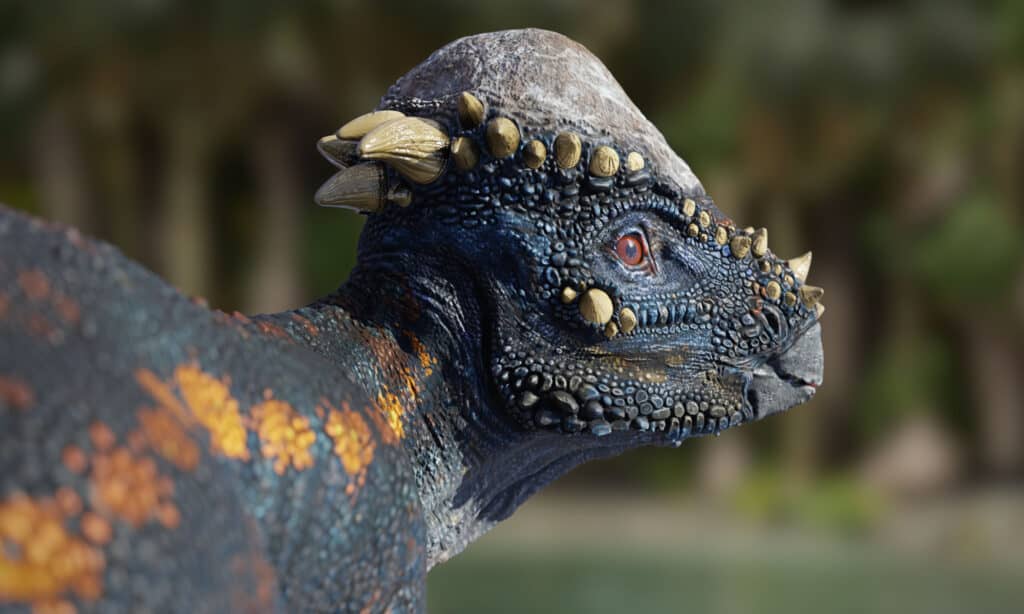
Pachycephalosaurus’ domed skull could be 10 inches thick.
©Dotted Yeti/Shutterstock.com
If you saw the fossilized skeleton of this beast who lived in the Late Cretaceous, you’d understand why its name means “thick-headed lizard” in Greek. In some places, the roof of this animal’s domed skull was 10 inches thick. Fossils of this dinosaur come from the Hell Creek and Lance Formations of North Dakota, Wyoming, and Montana.
Pachycephalosaurus most likely walked on two legs, had short arms and hands with five fingers, a short neck, a robust body, and a thick but rigid tail. Because its teeth were small and ridged, it was an herbivore that probably ate leaves, fruit, and seeds. It was about 15 feet long with a weight of between 820 and 990 pounds. Some scientists believe that the thickness of the animal’s skull protected its brain when the males rammed each other’s heads during fights over mates or territory. Others believe this was unlikely, and the dinosaur used its head to ram a rival’s flank.
2. Is the Plesiosaurus Still with Us?

Some people believe that this dinosaur still exists and lives in Loch Ness.
©Freer/Shutterstock.com
Some people who believe that the Loch Ness Monster exists believe it is a type of Plesiosaurus that managed to survive. The original Plesiosaurus lived in the early Jurassic period between 199.6 and 175.6 million years ago in England. Its name means “near lizard” in Greek. It was given the name because it was more like a reptile than Ichthyosaurus, another dinosaur unearthed from the same strata of rock.
The Plesiosaurus was an aquatic dinosaur that had a small head on a long, thin, flexible neck, a turtle-like body, four long, bony paddles, and a short tail. The animal grew between 9.4 and 11.5 feet in length and probably weighed about 408 pounds. Its jaws were full of sharp teeth for catching snails, clams, fish, and a now extinct animal called the belemnite. This animal was very much like a squid with a skeleton. Scientists believe that the Plesiosauruses were ambush predators instead of hunters. The turbulence caused by the animal’s long neck hampered it unless the neck was held very straight, and this made chasing after prey difficult. Plesiosauruses also gave live birth in the water like most coral reef snakes.
3. Pterosaurs, Incredible Dinosaurs of the Sky
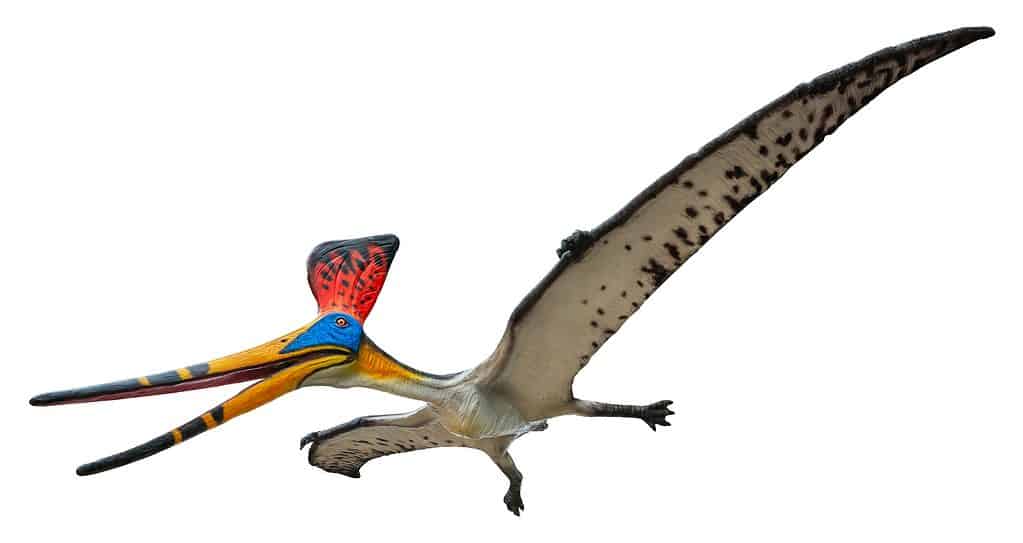
The Pteranodon was a type of pterosaur, and quite likely had a vividly colored head and crest.
©YuRi Photolife/Shutterstock.com
Pterosaurs are some of the coolest dinosaurs, probably for no other reason than they could fly. Indeed, scientists believe these dinosaurs were the first vertebrates to have evolved the muscles necessary for powered flight. Though they looked like birds and may have even had downy feathers, they weren’t birds at all but reptiles. Their fossils have been found all over the world.
The Two Types of Pterosaurs
The two main kinds of pterosaurs were basal, or early pterosaurs, and pterodactyls. The first group was smaller, had teeth in their jaws, claws, and long tails. Their wings were possibly attached to their hind legs, and they probably couldn’t move well on land and spent most of their time in the trees. They most likely ate insects and vertebrates that were small enough for them to handle. Pterodactyls had free hind legs, which allowed them to maneuver and take off, if awkwardly, on and from the ground. They had beaks, and in some species, the beaks were toothless, as with birds. Pterodactyls were warm-blooded and had coats that kept them warm in cool weather. They ranged in size from tiny Anurognathus, who had a 10-inch wingspan to the majestic and terrifying Quetzalcoatlus, with a wingspan of 36 feet.
Like modern birds, pterosaurs had varying diets. Some ate fish and other vertebrates, while others ate insects, or fruit, or even cannibalized other pterosaurs. They were also like birds in that they laid eggs and had hollow bones that made flying easier. Scientists believe that one individual in the Quetzalcoatlus species, for example, weighed only 143 pounds even though it was 11 feet tall and had a 16-foot wingspan. The age of the pterosaurs went from the Late Triassic to the Late Cretaceous periods, from 228 to 66 million years ago.
4. Paralititan, Dinosaur of the Tidal Flats

Paralititan was a member of a family of incredible dinosaurs called sauropods.
©Mercury Green/Shutterstock.com
This huge dinosaur lived during the Late Cretaceous period, from 99.6 to 93.5 mya. Its bones were found in a desert oasis in Egypt, but scientists believe that it lived among the mangroves of the tidal flat that was part of a prehistoric sea. Thus, its name is Greek for “tidal giant.” This sea, the Tethys, was found between Gondwana and Laurasia.
Scientists found enough of what was left of Paralititan to deduce that it was, at the latest estimate, 88.6 feet long and weighed 33 tons. It most likely had a very long neck, relatively short legs in proportion to the rest of its body, and a long rigid tail. Another dinosaur whose name starts with p, Puertosaurus, was probably even larger at 98 feet and 55 tons. It lived in South America in the Late Cretaceous period.
5. Parrosaurus, State Dinosaur of Missouri
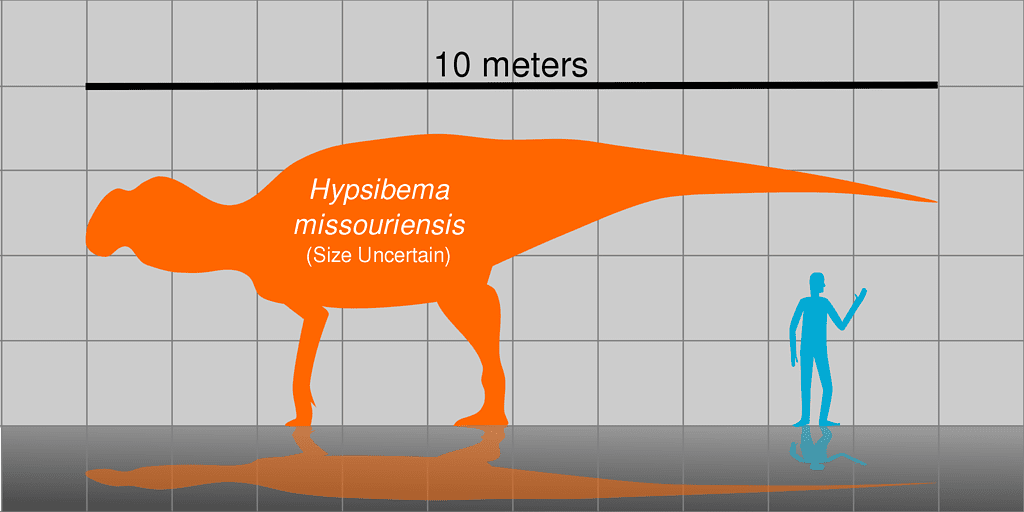
This shows the size of the Parrosaurus in relation to an average human.
©User:Slate Weasel, Public domain, via Wikimedia Commons – Original / License
Parrosaurus is the state dinosaur of Missouri, having been unearthed in the part of the Ripley Formation that’s in the state. There’s only one species of this dinosaur, and its scientific name is, appropriately, Parrosaurus missouriensis. For a while, it was known as the Chronister Dinosaur.
Scientists discovered enough of this dinosaur to deduce that it was a sort of hadrosaur, or duck-billed dinosaur, and that it lived in the Late Cretaceous period. It probably stood about 10 feet tall, was 30 to 35 feet long, and weighed about 2.7 to 3.6 tons. Like other hadrosaurs, it was an herbivore and had 1,000 teeth that were serrated to allow it to more easily chew the tough plants it ate. Parrosaurus was designated Missouri’s state dinosaur on August 28, 2004. Only five other states plus Washington D.C. have a state dinosaur.
6. Pelorosaurus, the “Monstrous Lizard”
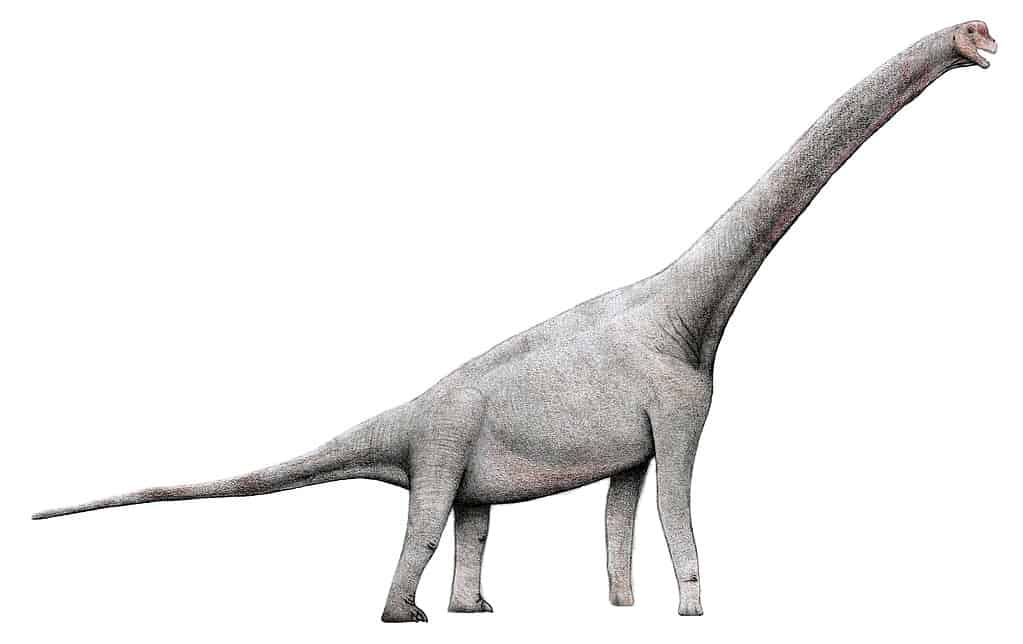
The name of this dinosaur means “monstrous lizard” in Greek.
Pelorosaurus was an enormous sauropod dinosaur that lived during the Early Cretaceous, which was between 140 and 125 million years ago. Its name means “monstrous lizard,” and it was one of the first sauropods to be identified as an actual dinosaur, as opposed to something like a sea monster. Deducing from the bones, including caudal vertebrae and humeri, scientists estimated that Pelorosaurus was about 79 feet long. Its bones were discovered in the 1840s.
7. Plateosauruses, Incredible Dinosaurs of the Late Triassic
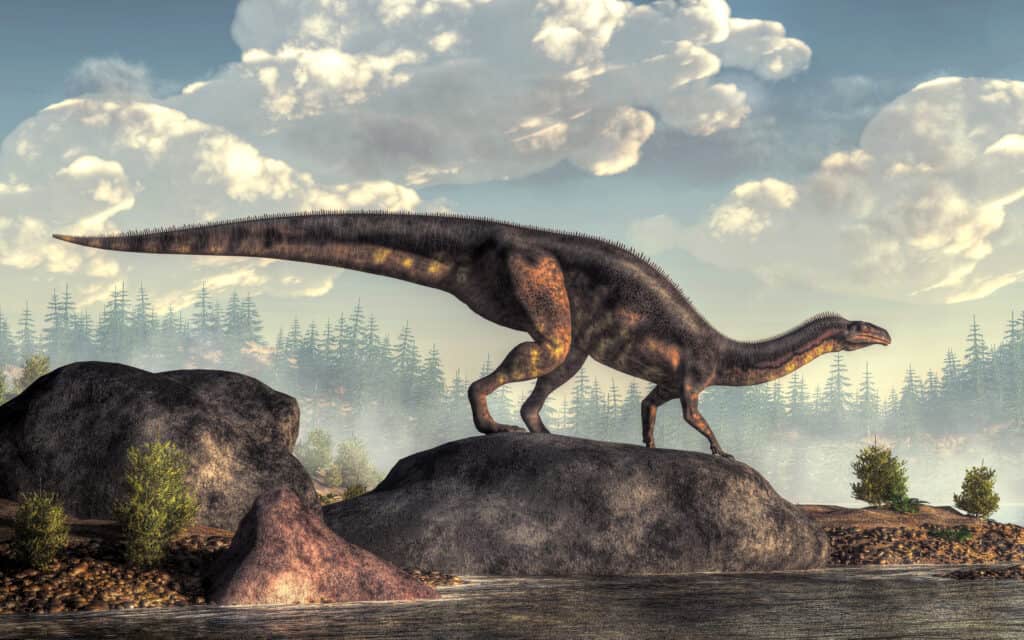
Though this picture shows Plateosaurus walking on all fours, it was an obligate biped.
©Daniel Eskridge/Shutterstock.com
This dinosaur, whose fossilized bones were found in Europe, lived in the Late Triassic, which was about 214 to 204 mya. Unlike a lot of dinosaurs, many skeletons of Plateosaurus have been found, and some are almost whole. This animal was bipedal and had short but powerful arms and hands whose three fingers had robust claws. It had a small head, a long neck, and a long, whippy tail. It had a nearly 360-degree field of vision that helped it look out for predators. Scientists could tell by its teeth that Plateosaurus was an herbivore.
Adult Plateosauruses varied in size and could be between 16 and 33 feet long and weigh between 1,300 and 8,800 pounds. Scientists even know how long these animals could live. Some lived as long as 20 years, but how long a Plateosaurus could live is still unknown.
For the longest time, scientists didn’t really know how this creature stood or moved. It was at first thought to be a quadruped until someone noticed that the radius and the ulna of the mounted skeletons were in the wrong place. When that was corrected, it was seen that Plateosaurus was not only bipedal but was an obligate biped. It could not comfortably move any other way except by walking on its hind legs.
8. Psittacosaurus, the Parrot Headed Dinosaur
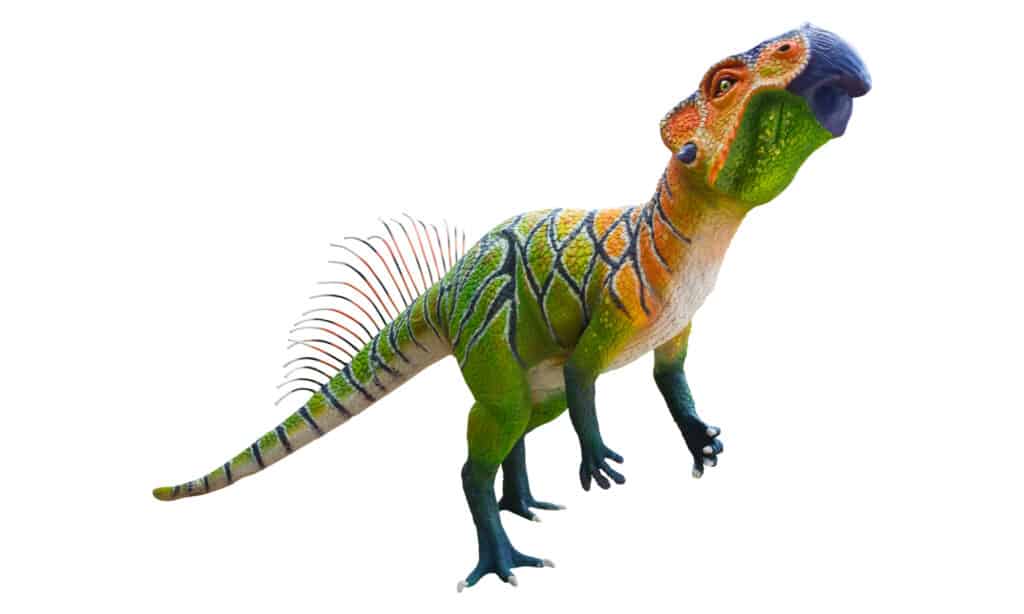
The incredible dinosaurs called Psittacosauruses were probably very colorful.
©YuRi Photolife/Shutterstock.com
Named “parrot lizard” because of the shape of its head and its powerful beak, this dinosaur lived in the land that became Asia in the Early Cretaceous, about 126 and 101 mya. It is unusual because scientists have named as many as 12 species of this dinosaur, and enough complete skeletons have been collected for them to know a lot about it. These skeletons range from newborns to adults. Some had bristles on their tail. The hide of at least one specimen was discovered. Its body covering was made up of scales which may have been of different colors.
All Psittacosaurus species were bipedal as adults, but they grew to different sizes depending on the species. For example, P. mongoliensis could be 6.5 feet long and weigh over 44 pounds, while P. ordosesis was about one-third as large. Though the animal had a parrot-like beak, it also had teeth that could crop the coarse plants that it ate. Like birds, the food was ground up by gastroliths that were probably found in a structure much like a gizzard.
The photo featured at the top of this post is © Catmando/Shutterstock.com
Thank you for reading! Have some feedback for us? Contact the AZ Animals editorial team.







